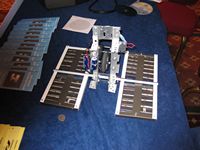Today was the last full day of this year’s ISDC conference and also a day which saw the two sessions devoted to the idea of a Space Elevator.
 The first session today was presented by independent researcher Jim Dempsey and was entitled Space Elevator Initial Deployment. Jim is not convinced that the tether deploymen proposed by Brad Edwards (i.e., placing an initial ribbon carrying a climber at Geo and then spooling the ribbon down to earth) will work, mainly due to ribbon fluctuations. He’s proposed an alternative, deploying many tether fibers individually down to earth and then, when a sufficient number of them are in place, sending a climber up the ‘bundle’, combining them into a tether as it goes. He has an Internet-reachable presentation which I’m unable to find at the moment – I”ll link to it when I can find it.
The first session today was presented by independent researcher Jim Dempsey and was entitled Space Elevator Initial Deployment. Jim is not convinced that the tether deploymen proposed by Brad Edwards (i.e., placing an initial ribbon carrying a climber at Geo and then spooling the ribbon down to earth) will work, mainly due to ribbon fluctuations. He’s proposed an alternative, deploying many tether fibers individually down to earth and then, when a sufficient number of them are in place, sending a climber up the ‘bundle’, combining them into a tether as it goes. He has an Internet-reachable presentation which I’m unable to find at the moment – I”ll link to it when I can find it.
 Incidentally, I’ve mentioned Jim in a couple of previous posts (here, where he related a very prescient observation from Sir Isaac Newton, and here, where he weighs in on the paper by Nicolas Pugno) and he will be presenting at this year’s Space Elevator Conference.
Incidentally, I’ve mentioned Jim in a couple of previous posts (here, where he related a very prescient observation from Sir Isaac Newton, and here, where he weighs in on the paper by Nicolas Pugno) and he will be presenting at this year’s Space Elevator Conference.
.
 Next up was a joint presentation by Ben Shelef of the Spaceward Foundation and Bert Murray of the National Space Society (NSS) Space Elevator Team. Ben went first and gave an overview of the Space Elevator Games, discussing how/why they were founded, their history and their current status.
Next up was a joint presentation by Ben Shelef of the Spaceward Foundation and Bert Murray of the National Space Society (NSS) Space Elevator Team. Ben went first and gave an overview of the Space Elevator Games, discussing how/why they were founded, their history and their current status.
 Bert then took the stage and gave an interesting presentation of what the NSS team is planning to do. The prize money for theClimber/Power-Beaming competition is being awarded in two different levels; $900,000 for a single winner with valid climb of 2m/s and $2,000,000 for a single winner with a valid climb of 5m/s. The NSS team is going for the whole $2,000,000.
Bert then took the stage and gave an interesting presentation of what the NSS team is planning to do. The prize money for theClimber/Power-Beaming competition is being awarded in two different levels; $900,000 for a single winner with valid climb of 2m/s and $2,000,000 for a single winner with a valid climb of 5m/s. The NSS team is going for the whole $2,000,000.
 Finally, we have a photo of the “concept” climber built by the NSS Space Elevator team. It is the one they used in the BBC documentary I blogged about here. It is a small unit (for reference, I placed a quarter on the table just in front of it), but appears very rugged and efficient. And, obviously it worked…
Finally, we have a photo of the “concept” climber built by the NSS Space Elevator team. It is the one they used in the BBC documentary I blogged about here. It is a small unit (for reference, I placed a quarter on the table just in front of it), but appears very rugged and efficient. And, obviously it worked…
.
I’ll do a wrap-up post tomorrow or Monday.
(As always, click on the thumbnails for a larger version of the picture)

Pingback: ISDC 2008 - Day 3 - Out of the Cradle
Pingback: ZEITGEIST
Can someone explain how these constructs won’t be affected by the magnetic fields??
I thought that such ribbons would generate current?
I always thought the 5% gravity reduction breakthrough described in Nick Cook’s “Hunt For Zero Point” would be perfect to place under the elevator itself. Any reduction in weight will help the climber and preserve the ribbon.
‘Course, anti-gravity devices are said not to exist…
Poshboy: Perhaps we could also install a four-dimensional pyramidal timecube onto the climber to assist with the gravometric spaciotemporalization.
It’s nice to dream, but the space elevator will exist only in the realm of science fiction. Its supporters have minimized the problem of the avoidance of satellites and debris. There are just too many objects orbiting the Earth for the elevator to successfully dodge indefinitely, regardless of the hoped-for pie-in-the-sky tracking systems some people call on to solve this problem.
Most of the debris is just that, debris. A good laser can take care of them. ‘Dead’ satellites can be taken care of the same way. The only issue (IMHO) are ‘live satellites’. There is not going to be many of these and these can be handled by a) either moving the Space Elevator (which is why it’s going to be built on a movable ocean platform) or else zapping it too (with the agreement of the owner) in return for offering a couple of free launches (or some other satisfactory arrangement).
Nice post which The first session today was presented by independent researcher Jim Dempsey and was entitled Space Elevator Initial Deployment. In which Ben went first and gave an overview of the Space Elevator Games, discussing how/why they were founded, their history and their current status. Thanks a lot for posting.